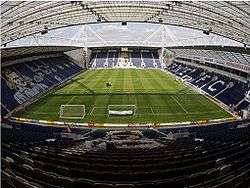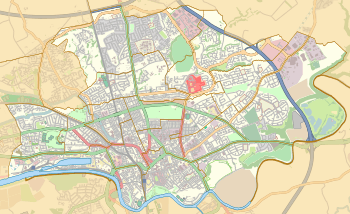Deepdale
 | |
 Deepdale Stadium Location in Preston | |
| Full name | Deepdale Stadium |
|---|---|
| Location | Sir Tom Finney Way, Preston, Lancashire, PR1 6RU, England |
| Coordinates | 53°46′20″N 2°41′17″W / 53.77222°N 2.68806°WCoordinates: 53°46′20″N 2°41′17″W / 53.77222°N 2.68806°W |
| Owner | Preston North End F.C. |
| Operator | Preston North End F.C. |
| Capacity | 23,404[1] |
| Field size | 110 by 75 yards (101 m × 69 m)[2] |
| Construction | |
| Built | 1875 |
| Opened | 1878 (for PNE) |
| Tenants | |
|
Preston North End F.C. (1878–present) Lancashire Lynx (1996–2000) | |
Deepdale is a football stadium in the Deepdale area of Preston, England, the home of the Lillywhites, Preston North End and, up to 2010, England's National Football Museum.
History
The land on which the stadium stands was originally Deepdale Farm. It was leased on 21 January 1875[3] by the town's North End sports club and originally used for cricket and rugby. It hosted its first association football match on 5 October 1878. The league record attendance for Preston North End at Deepdale is 42,684 v Arsenal in the First Division, 23 April 1938.[2]
All four of the original stands have been replaced by new all seated structures named after famous Preston North End players.
The old 'Pavilion' stand, was replaced by the 'Invincibles Pavilion', opened for the 2008–09 season. It is named after the Preston North End team of 1888–89 season who were the first League team to go an entire season unbeaten, and the first to complete the league and F.A. Cup double.[3][4] Deepdale now has a capacity of 23,404 and is an all seater stadium.
The women's team Dick, Kerr's Ladies also played at Deepdale, often beating men's professional teams in front of large crowds.[5] The venue was used during the 2005 UEFA Women's Championship.
On 19 December 2015, Carlisle United played a home League Two match against Notts County at Deepdale, making the 85-mile journey due to floods at their Brunton Park.[6]
Deepdale holds the distinction of being the stadium that has had the longest continuous use for association football in the world.
National Football Museum
Formerly located at the Deepdale stadium in Preston, the National Football Museum opened in June 2001 and closed in 2010 in order to relocate to Manchester. It was an independent charity holding the following collections:
- The FIFA Museum Collection
- The Football Association Collection
- The Football League Collection.
- The Wembley Stadium Collection.
- The FIFA Book Collection
- The People’s Collection
- The Preston North End F.C. Collection
- The Harry Langton Collection
- The Sir Stanley Matthews Collection
- The Littlewoods Collection
The old site, on the corner of the Sir Tom Finney Stand and the Bill Shankly Kop, is now home to Heartbeat. They are a Cardiac Rehab charity who provide exercise and support to over 700 people every week. [7]
Old Deepdale
As football grew in popularity, it became necessary to have raised areas, so the idea of football terracing was formed. In the 1890s Preston built the west paddock, which ran along the touch line and a tent was erected to house the changing rooms. At the turn of the century crowds started to grow with crowds of over 10,000 and in 1921 they had to expand again. The Spion Kop was built and the West Paddock was extended to meet the Kop end. The pitch was removed to allow the building of the Town End. The Paddocks and Kop End allowed fans to move under the terracing. The Town End was completed in 1928 but was destroyed by fire only five years later. The Pavilion Stand, a relatively small stand of 2 tiers holding the changing rooms and offices, was built in its place and opened in 1934.
During the 60s and 80s, big changes took place as roofs were placed on the stands, seating was installed and terracing extended.[8]
Renovation
The regeneration of Deepdale began in 1995 when the old West Stand was demolished to make way for the new £4.4m Sir Tom Finney Stand which has a capacity of 8,100[9] and includes press areas and restaurants. The next stand to be developed was the 6,000 seater Bill Shankly Kop in 1998. The National Football museum ran underneath these stands with the entrance at the corner of the two. In 2001, the roughly 6,000-seater Alan Kelly Town End was next to be built replacing the popular Town End terrace.
The old Pavilion terrace was closed in 2006, however fans could still use the seated upper tier until it was eventually demolished in 2007. In 2008, the new 5,000 seater Invincibles Pavilion opened to complete the regeneration of Deepdale, giving it a new capacity of 23,404.[9] The Invincibles Pavilion includes a row of executive boxes and a restaurant which overlooks the pitch as well as the Stadium Control Room, PA Box and Big Screen Control Room and an NHS walk-in centre has also been built into the stand. In 2008, a 25-metre screen was also erected on the roof of the Bill Shankly Kop.
The original plans for the re-developed stadium were inspired by the Luigi Ferraris Stadium in Genoa, Italy.[10]
Plastic pitch
In 1986, Preston North End decided to lay an all-weather pitch to try to generate some extra income for the club by renting the pitch to local teams to play on, to reduce the number of postponed matches as well as enabling the use of the Deepdale pitch as a training ground.
It was one of four football stadiums in the English league to feature a plastic pitch, but this proved to be unpopular with the fans and was finally ripped up in 1994, by which time it was the last remaining plastic pitch in the English league.[11]
Sir Tom Finney statue

Outside the Sir Tom Finney Stand, is a statue of the famous player himself, sculpted by Preston-born sculptor Peter Hodgkinson. The statue, unveiled in July 2004, was inspired by a photo taken at the Chelsea versus PNE game played at Stamford Bridge, in 1956.
The game was in 1956. There had been a big downpour just before the kick off. The match would not have been played today because there were huge pools of water on the playing surface. I was going past a defender and the ball ran in to a pool of water. It was a fantastic photograph and it won the Sports Photograph of the Year award. The sculpture is a true likeness.
England
Deepdale was used as the venue for the England under-21s when they played Iceland in March 2011. Deepdale was used again at the end of the 2011–12 season to host three under-19s Elite Round matches with England, Slovenia and Switzerland all taking to the famous pitch. The three games were held at the end of May over six days.
References
- ↑ Duncan Adams. "Preston North End FC: Deepdale". Football Ground Guide. Retrieved 7 November 2014.
- 1 2 "North End Statistics". Preston North End FC. 3 April 2008. Archived from the original on 9 December 2008. Retrieved 22 November 2011.
- 1 2 "The History of Preston North End". Preston North End FC. 7 January 2009. Archived from the original on 2 October 2009. Retrieved 22 November 2011.
- ↑ Taw, Thomas (2006). Football's Twelve Apostles: The Making of The League 1886–1889. p. 17. ISBN 1-905328-09-5.
- ↑ Hunt, Chris (August 2005). "The Belles of the Ball: Dick Kerr's Ladies". FourFourTwo. Archived from the original on 6 July 2011. Retrieved 22 November 2011.
- ↑ Cartwright, Phil (20 December 2015). "Football League: Five things you may have missed". BBC Sport. Retrieved 20 December 2015.
- ↑ http://www.heartbeat-nwcc.org.uk/
- ↑ "Deepdale Stadium History". Archived from the original on 23 April 2009. Retrieved 22 November 2011.
- 1 2 "Deepdale". Preston North End FC. 15 February 2012. Archived from the original on 26 November 2009.
- ↑ "Preston North End Ground Guide". 2008. Archived from the original on 7 March 2009. Retrieved 13 March 2009.
- ↑ Fletcher, Paul (18 November 2011). "Could artificial pitches be set for a return to Football League?". BBC Sport. Retrieved 22 November 2011.
- ↑ "Sir Tom Finney - One of football's all-time greats". LFChistory.net. Archived from the original on 16 July 2011. Retrieved 30 June 2009.
External links
| Wikimedia Commons has media related to Deepdale (stadium). |